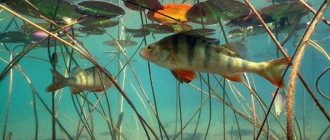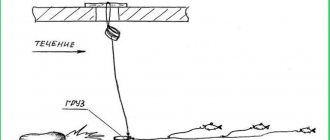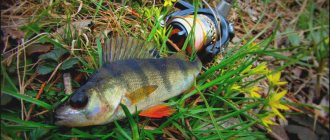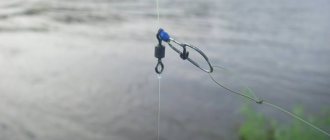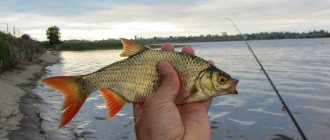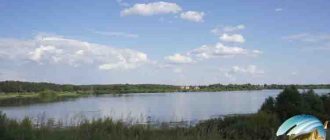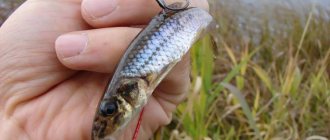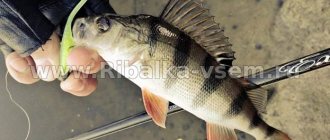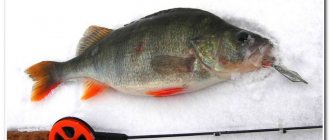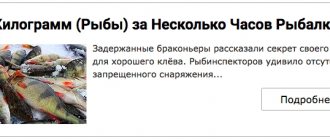Perch is active throughout the year. But the most exciting time to catch this prickly and striped predator is in winter. This is due to the fact that when fishing for perch in winter from ice, delicate and ultra-sensitive gear is used, and the energetic bites of perch and the schooling nature of the fish make spiny stripers one of the main objects of winter fishing.
Where and when to catch perch in winter
Throughout the winter, flocks of spiny minke whales can be found in a wide variety of places. In any case, you need to look for perches on the river. During different periods of winter they can be concentrated in different places. During warmer periods, schools of perch should be looked for close to the shore, near vegetation, at shallow depths. And with a strong drop in temperature, the search location must be changed towards deeper places in the river, where all the fish migrate. In such places in the wilderness, the temperature regime is about 4°C.
The most comfortable winter fishing for perch usually occurs at a depth of one to two meters. Therefore, there is no need to lower the bait deeply, which is a plus and eliminates some inconveniences during fishing. The most promising places for catching perch in winter are:
- Sandbank with a depth of half a meter to two meters;
- Any edges from the bank to the riverbed;
- Border between reeds and clear water;
- Hill at the bottom;
- Places with changes in soil composition;
- Trees fallen into the water.
Sometimes unfavorable weather conditions can put an end to perch fishing in winter - changes in atmospheric pressure, strong wind, its direction and even humidity.
It is necessary to go in search of striped humpback whales in calm and clear weather with stable atmospheric pressure. Usually the best perch bite is in the morning, and in the afternoon and evening the activity is much worse. But if there was no bite in the morning or during the day, then the probability of an evening bite is very high. Therefore, in this case, there is definitely no need to rush to leave the pond.
Our detailed article on ideal perch biting conditions.
Behavior of perch under ice
In the vast majority of cases, perch lives in schools underwater. The smaller the individual, the larger the flock. Most often, palm-sized minke whales gather in schools of one and a half to two dozen. Moreover, catching some individuals does not scare off others at all. Therefore, once you find a flock, you can catch it all to the last tail. The larger the striped humpbacks, the smaller the flock size. Trophy individuals over 1.5 kg generally stay apart.
Watch a video about the behavior of perch under ice:
Drilling holes and tactics for finding places
In the case of perch fishing, you should not underestimate the importance of a high-quality drill, because you will have to drill a lot. Sometimes when searching for schooling perch, the number of holes drilled is in the hundreds. The most popular technique for drilling holes is the checkerboard pattern. The distance between the holes is several meters from each other. Both in shallow waters and on the edges, this option most promisingly covers the fished area. One of the promising options in perch fishing is baiting. In this way, small things are attracted and held to the hole, and then the perch comes up behind it.
What type of reservoir is needed for perch fishing?
Firstly, the pond should not be too small. Of course, striped robbers are found in the most shabby puddles, and in small ponds, and in swampy barrels.
However, in such places you can catch soup perch, but not humpback salmon. For thick winter perch, you need to go to a completely different type of reservoir.
A river, reservoir or lake where there are sufficient depths and good drops is suitable for you. It is in such places that you can catch good perch in winter, although this rule will also work for summer fishing.
Places where several channels join together, where a channel between two islands converges, where the current rises after a hole or, on the contrary, falls into a hole, will generally be a “Klondike” on which you can “mind” your “striped gold”.
Fishing for perch in winter using lures
Many anglers are of the opinion that the option of catching perch with a spoon is unpromising.
However, it is necessary to take into account that fishing does not tolerate stereotypes and there are days when it is the spinner that works. The range of spinners for winter fishing is quite wide. The lures of the post-Soviet space “gvozdik”, “zhuk”, “uralskaya”, “karasik”, etc., which have gained their popularity over many decades. can be considered eternal. They are successfully used on an equal basis with modern imported “Hanski” from “Nils Master” and “Lucky John Scandi” . The optimal spinner size is 3 cm long.
Our rating of the top 14 spinners.
At the beginning of winter, on the first ice, dark-colored spinners are more promising, and as winter progresses, switch to light options. Sometimes a positive result comes from attaching bloodworms or pieces of red thread to the spoon. The catchability of the spinners is increased by a tee with a drop, a chain and an additional hook.
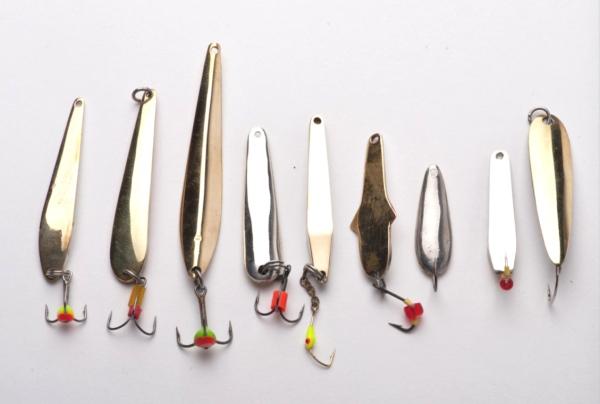
The most convenient option for trolling would be a regular winter fishing rod 50 cm long with a nod. The optimal length of the whip is 30 cm, and it will be better if it has several access rings. The tackle must be equipped with a fishing line with a diameter of up to 0.15 mm, and when hunting trophy perch it is better to use the more reliable 0.2 mm option. Blind installation of gear is inconvenient, which is why it is used less often. The required supply of fishing line on the reel is 10 m. The fishing line must be renewed annually.
Video about catching perch in winter with a spoon, youtube:
As with other methods of winter fishing, catching perch with a spoon involves fishing a large number of holes. At the same time, each hole is fished very carefully. First, the spoon sinks to the bottom. Then the bait must be raised 2-3 cm from the bottom and played along with a rod with an amplitude of about 10 cm. Thus, the spoon gradually rises to the very top of the reservoir, periodically playing along with the same amplitude.
On the first and last ice, when the fish is more active, it is advisable to make strokes of 30-40 cm in size. Moreover, at the extreme points of the game - at the top and bottom - it is promising to make pauses of about 5 seconds. Very often bites occur during pauses. If after 20-30 lifts there is no result, then you need to move on to another hole.
What parts are used to make the tackle?
When fishing for perch on a bulldozer, you use a short fishing rod, the end of which is reinforced with hard material, which helps you play the bait in the right directions. A soft nod on the rod in the form of a silicone tube registers the moment when the rod touches the bottom and records the bite. When using one tool, but at different depths of water, it is equipped with a device for winding and unwinding fishing line onto a plastic reel. You can build a boom yourself; this tackle is simple in design and does not require special skill to install the elements.
Materials are selected from household items or purchased at a retail outlet:
- the lead weight is elongated in shape, resembling a drop with a drilled hole in the narrowed part;
- 2 identical hooks placed on the sides of the sinker on the fishing line; for this, tie a loop;
- bright beads , multi-colored fragments of a plastic tube that has elasticity and flexibility.
Hooks are selected smaller in size than the attached load with the points directed in different directions. The fisherman selects tackle in accordance with the parameters of the perches that live in a given reservoir; if the fish is small, a small one is attached and vice versa. Beads are strung on each hook and decorated with colored cambrics.

Painted in colors:
- black
- brown
- green
Experiments can be different with coating the lower part of the bulldozer in a red tint or leaving it in its original form, since the paint doesn’t last long anyway. Each master observes the preference of the perch and decides how to modify the bass. They figure out how best to attach the hooks, build a sinker that is not lead, but:
- tungsten
- bronze
- copper
Each fisherman has his own differences in making the shape of the bulldozer. The lower part of it is sealed, filling the middle with metal balls, causing the bulldozer to rattle. The device can cause a bell effect if a fishing line with a ball from a small bearing is passed through a hole made throughout the body of the sinker. Various additions to the bait increase the number of bites.
Watch a video about underwater filming of perch fishing.
Catching perch with a jig
Jig fishing for perch is considered more delicate compared to trolling, which is why the tackle here is somewhat more delicate.
The tackle is based on a fishing rod up to 25 cm long. The classic fishing rod for jig fishing is the “balalaika”. It is comfortable, light and fits perfectly in the hand. The optimal nod is a version 5 cm long and 2-3 mm thick. When fishing with a jig, the optimal choice of fishing line is very important. Some anglers use options with a diameter of 0.15 mm or more, while others prefer a sporty approach to this issue and use a fishing line of about 0.05 mm. Both of these options are hardly acceptable in ordinary and sane fishing. An excellent choice in this case would be an intermediate option - about 0.1 mm. It is necessary to reel about 20 meters of fishing line onto one jig tackle.
There should be a golden mean in choosing a jig. A light jig will sink to the bottom for a very long time, and a heavy jig will fall catastrophically quickly, hitting the bottom and demonstrating a game that is not interesting to the fish. For a standing reservoir, the optimal weight when choosing a jig is considered to be about 0.3 grams.
Tungsten jigs are much more convenient than lead jigs - they are smaller in size with the same weight. The color and shape of the jig are absolutely insignificant, and are more necessary to please the angler’s eye. In any case, the jig should not be empty - two or three bloodworms should be attached to the hook. And with a good bite, one will be enough.

Very popular in perch fishing are miniature vertical jigs - devils. The size of such a bait is about 5-7 mm in length and 3-4 mm in diameter.
Technique for catching perch with a jig:
- After lowering the jig to the bottom, the fishing rod must be raised to a height of up to 30 cm, while making some vibrations with the bait;
- After several taps of the jig on the bottom, it is necessary to raise the jig to a small distance of about 5 cm;
- Raising the jig from the bottom by 20-30 cm and tapping the whip with your finger;
- Twitching the jig at the very bottom using short pauses of about 2-3 seconds.
Balancer fishing technique
Catching perch using a balance beam is not as popular as the previous method. This is due to the fact that when fishing with a balance beam, there is a high probability of empty bites - about 20%. When fishing in this way, the tackle should be rigid and balanced, preferably with a nod. The reel should be of an open type - it is easier to control the depth. When fishing in this way, fishing the hole begins from the upper layers and gradually moves to the bottom area. When fishing passively, it is advisable to reduce the amplitude of play with the rod and increase the pauses. When the perch is active, jerks with the rod need to be performed more aggressively.
The standard size of a perch balancer is 3-4 cm . Most often, the weight of such baits is 4-6 grams. There is a huge variety of color options for these artificial baits. Sometimes natural colors work, and sometimes poisonous ones. If there is no bite at all, one of the tactics is to experiment with bait colors.
Perch prefers poisonous bait colors over natural ones. The most popular perch balancers are Kuusamo Tasapaino and Tasapaino Pro, Lucky John . These world-famous lures can work real miracles - they have a smooth action, and when the bait falls, they swing from one side to the other, irritating the prickly stripers.
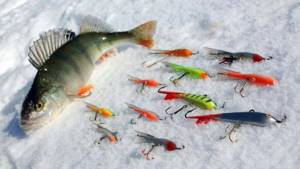
Fishing with a balancer begins by lowering it to the bottom. Then, gradually rising, the entire layer of the reservoir is fished. Sometimes, during periods of warming, striped humpback whales stand at the very surface of the reservoir.
When fishing with a balance beam, there is a high probability of catching a pike, so an appropriate leash against pike teeth will not be superfluous.
The most popular ways to play balancers are:
- After lowering the bait to the bottom, it is tossed approximately one meter. During its further lowering, a technique is performed with the rod that simulates shaking. Such movements are usually performed from five to ten.
- After lowering the bait to the bottom, it is tossed approximately 30 cm. After the balancer falls freely, a pause is made for about 5 seconds. Such movements are usually performed from five to ten.
- After lowering the balancer to the bottom, it rises with an amplitude of about 20 cm. After each rise, you need to pause for about 5 seconds.
- Playing with a balancer in the surface layer with barely noticeable movements of the rod. In this case, there is a slight play of the bait with the corresponding movements of the lower tee.
- After lowering the balancer to the bottom, it is undermined by 40 centimeters and paused for 5 seconds. After a pause, another blast is performed approximately 40 cm and again a pause is made for 5 seconds. After this, the bait smoothly sinks back to the bottom.
Selection and features of gear for catching perch in December
Winter fishing rod

Almost any winter fishing rod is suitable for striper fishing in December. There will also be no difficulties with the selection of fishing line - perch, as a rule, does not tear it.
Meanwhile, you should especially carefully choose a nod, while taking into account the weight of the bait. So, when trolling, a fairly rigid nod may be suitable, no more than 6 centimeters, in which the bending angle under the weight of the lure is about twenty to thirty degrees.
Most often, despite the variety of gear, anglers on the first ice still prefer to catch perch using the trolling method. Thus, you can catch a large minke whale, sometimes even a trophy one. In addition, according to anglers, the striped robber is more likely to notice a spinner than a small jig.
At the same time, I advise experienced fishermen to take a variety of baits:
- spinners,
- balancers,
- jigs.
This is due to the fact that sometimes only during fishing can you determine which of these baits will appeal to the perch more. Let's look at each of them in more detail.
Spoon

Lure fishing is a classic of perch fishing. Experienced fishermen advise drilling holes at a distance of ten meters from each other. Fishing rods for trolling perch are a rod with a reel, a whip two to five to thirty centimeters long and a nod made of nipple rubber or a nod made of lavsan.
In addition, it is possible to use a “filly” - a winter fishing rod without a nod, with a foam or cork handle and a carbon fiber whip, 35-40 centimeters long
We wind 0.12-0.16 fishing line on these fishing rods - it all depends on the depth in this place, as well as how much the bait weighs. Spoons for catching perch on the first ice should be small - thirty to fifty millimeters in size.
Balance
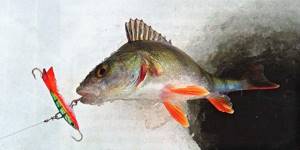
Catching perch using balance beams is very popular, including in winter. On the first ice, baits ranging in size from twenty to seventy millimeters are suitable.
Mormyshka
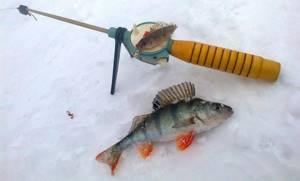
Fishing for perch using a jig is also one of the most popular. At the same time, the fish reacts not so much to the shape of the jig, but to the play with it.
The jig should be small or medium. The shape of this bait can be as follows:
- spherical,
- spherical,
- rectangular,
- large cylindrical.
In the horizontal plane, the jig should not be longer than five to seven millimeters.
The best attachments for jigs are:
- burdock moth larva,
- small maggot.
If you fish without baits, then the game should be very fast, up to 300 vibrations per minute. But even in this case, it is recommended to wear a dark or bright cambric on the shank of the hook for successful fishing.
Fishing for perch on a bulldozer
The equipment, which is called a balda, was originally used in sea fishing. Then, having moved to the continent, it was first used by fishermen of Siberian rivers, and then appeared in our area. Moreover, for catching perch this equipment is used not only in winter, but also in summer.

Read a detailed article on catching perch on a bulldozer.
The gear is based on a loop, in the center of which a symmetrical weight is placed through a hole, and on the sides of the load there are hooks. Instead of bait, cambrics or beads are put on the hooks. The fishing rod for fishing on the rod should be rigid, and the nod should bend slightly under the action of the equipment.
The principle of operation of the bulldozer is as follows:
- A vertical swing is made with the rod, as a result of which the equipment is thrown half a meter under water;
- The equipment falls to the bottom and forms a cloud of turbidity, which attracts perches;
- There is a pause for a few seconds;
- Swimming up to a muddy cloud, the perch grabs hooks with cambrics.
The rig with a boom is convenient because it does not contain live bait, so in the cold winter you do not need to freeze your hands to rig the hooks. In addition, the equipment has a decent weight, so it quickly reaches the bottom, which is a significant advantage compared to jig fishing.
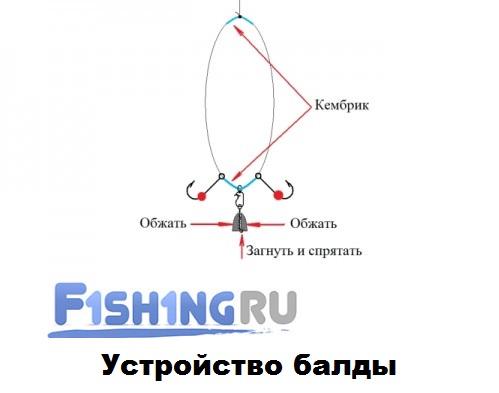
The main secret of this rig's catchability lies in the cloud of turbidity, which attracts spiny stripers. The more turbidity, the more effective the fishing will be. In this murky cloud, the perch cannot see the bait well and rushes to hooks with artificial cambrics or beads.
To assemble the equipment you will need the following components:
- fishing line with a diameter of 0.2-0.25 mm and a length of about 20 cm;
- two hooks with Russian numbering 4 or 5;
- beads or cambrics;
- a weight in the form of a bullet with a hole at the end.
Red, yellow and green colors of beads and cambrics are the most promising.
The weight of the load in the rig depends on the presence of a current and its strength. For a standing reservoir, the weight of the load can reach up to 10 grams, and for a river, sometimes even 25 grams is not enough.
Some anglers add another hook to the rig about half a meter higher from the load. Moreover, sometimes bites can only occur on this additional hook.
Fishing tactics in December
Experienced fishermen claim that there is no single tactic for catching fish, and it is always worth experimenting when fishing. But there are some unspoken rules that almost everyone adheres to. First of all, the spoon is released to the bottom, and then rises 5-10 centimeters, it is difficult to say exactly how to do this, it all depends on experience. Which is developed over time, but beginners will have to rely on intuition.
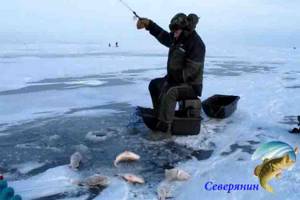
As soon as the spoon is lifted from the bottom, a couple of swings of the fishing rod are made, not at all large, with pauses of two or three seconds between the first and second swing. The amplitude of the swing of the fishing rod should not be very large and very sharp; it will be enough to just raise the spoon by 10 cm during the swing. Beginners usually make this mistake. This tactic is used throughout the rise of the spoon right up to the hole. If there is no bite, then you should change the hole and not linger on it, this has already been said above.
Features of winter perch fishing
No matter what gear is used when fishing for perch and no matter what time the fishing is done, a huge share of success depends on the activity of the angler.
Quickly fishing holes and searching for schools of perch increases the results of perch fishing. Sometimes an angler has to travel kilometers on ice to get a significant result. But if the site of the spiny minke whale has already been discovered, then a positive result will not be long in coming. Some fishermen, when catching perch, feed it with bloodworms. This tactic makes it possible to keep the fish in one place for one or two days.
Winter perch fishing is unpredictable - sometimes you can catch a bag of fish from one hole, and sometimes you can walk many kilometers without seeing a single tail.
Fishing in December, first ice
The most long-awaited perch fishing period of the year by all anglers begins in December, or rather a week after the reservoir is covered with ice. The period of active perch feeding can last from a week to two. At the beginning of winter, it is advisable to look for perch in shallow places from half a meter to two meters, on various bottom elevations, on the near edge. The best December weather for perch fishing is sun, slight frost and light south wind.
Choosing a place and time for December fishing
Where to fish?
In December you should look for perch in the following places:
- Small individuals - in shallow areas and in bays of reservoirs where thickets are present
- Large individuals live on dumps.
For successful fishing you need the right tactics to find this striped robber. In December, perch are usually dispersed throughout the reservoir. Therefore, to search for it, you should actively move on the ice,
So, it’s worth drilling a couple of holes near the reed thickets, along the coastline, where the depth is no more than two meters. The distance between the drilled holes reaches about ten meters.
When to catch?
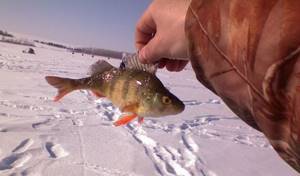
First ice is the most promising time for perch fishing in December. This month, the striped predator lives near coastal vegetation and on dumps. At this time, it can be successfully caught using spoons, balancers, jigs - with a nozzle and without a reel.
For successful perch fishing in December, sunny and windless weather with slight frost (optimally - up to minus five degrees) is suitable.
Unfortunately, in recent years, the month of December often does not justify anglers’ hopes for good bites. This is explained by weather anomalies, due to which reservoirs are covered with ice only at the end of the month, when the dead winter already sets in.

